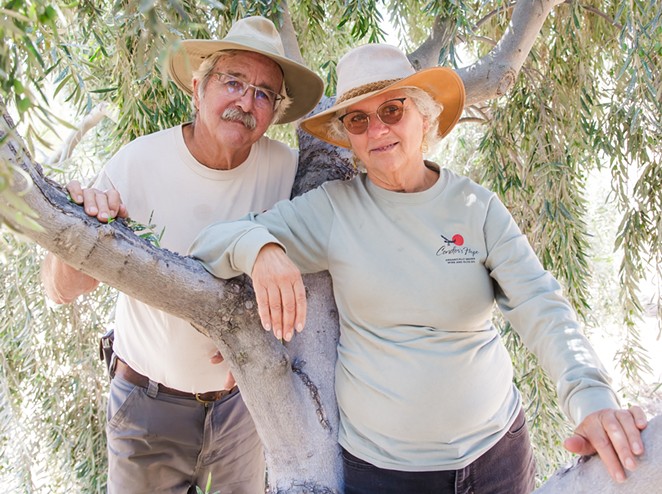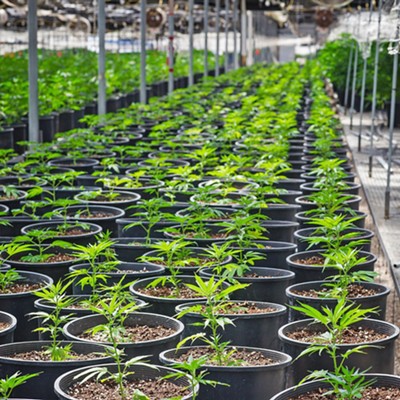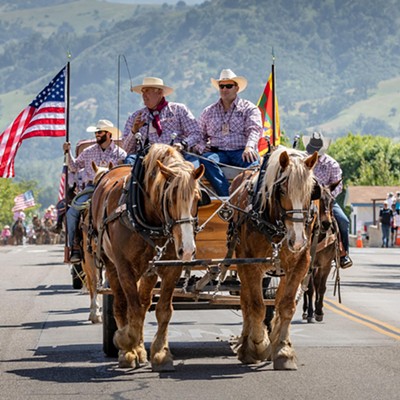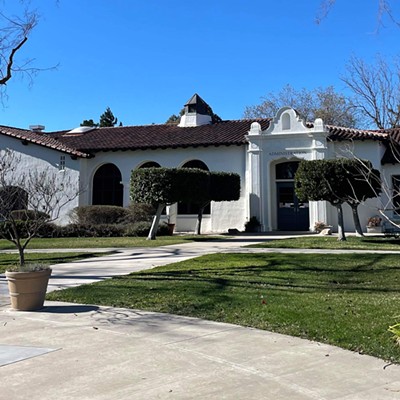Birds caw and squawk as he approaches a row of zinfandel grapes.
“That’s our sound system playing distress calls of a bunch of pest birds,” Gliessman explains. “We think it helps, along with the flashy tape and the predator eyes—keeps the birds away long enough to harvest. It’s kind of annoying but it does its job.”
The balloons mimicking a predator bird’s eyes dance above Gliessman as he grabs a purple bunch weighing down a vine and pops a grape in his mouth with a crunch.
“Almost ready,” he says. “Not bad—22, 23 percent. We want 25.”
It’s September and the grapes’ sugar content still has a few more weeks to mature before they’re ready to be harvested. Visitors have been coming to Condor’s Hope Vineyard to help harvest its 5 acres of zinfandel, syrah, chardonnay, and pinot grigio, and Gliessman expects to host a few more groups in October.
“I’ll be much more at peace when all of these grapes are out of the field and into the winery,” he says.
Growing up, Gliessman spent summers on his grandmother’s farm in Delano and has always found a connection with plants and nature. In 1980, he moved to Santa Cruz to teach agroecology—how to farm in harmony with the surrounding environment—at UC Santa Cruz. There, he met his wife, Roberta Jaffe, who grew up farming in upstate New York and worked in the school’s garden at the time.
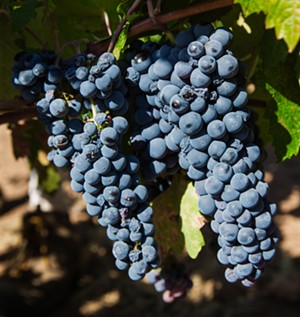
After they got married, Gliessman, 77, and Jaffe, 73, purchased their 5-acre property in 1992, now called Condor’s Hope Vineyard. The couple retired from their Santa Cruz jobs and live in Cuyama full time where they dry farm grapes and olives and sell their wine to wine club members across California and local vendors.
Dry farming practices train grapes’ roots to reach deep into the soil, with records showing some roots reaching about 150 feet below the surface, he says. Instead of using a trellis system, they prune the vines and leave space to till the soil—which helps improve the soil quality and allows water to saturate the ground rather than staying on the surface.
“Every single plant is a work of art. Every one is different, each has its own character,” Gliessman says.
By dry farming, they use less than 2 acre-feet of water (about 652,000 gallons) per year, Jaffe says while sitting next to her husband. In contrast, agricultural corporations Bolthouse Farms and Grimmway Farms pumped 28,500 acre-feet last year out of the same aquifer—enough to supply three cities the size of Santa Barbara with water for a year, according to Stand With Cuyama, a group of farmers now organizing a carrot boycott.
“We thought we’re going to have our nice little farm, we’re going to be away from everything, we’re in the middle of nowhere, it’ll be just really peaceful. Then the water issues started [getting] very serious,” Jaffe says.
A 2012 United States Geological Survey study that looked at the Cuyama Valley Groundwater Basin’s conditions found that agriculture can’t continue the way it has in the past, Jaffe says.
“Why can’t we literally realize we are all on the same boat? [It] is a funny analogy, but that boat is sinking,” she says. “We don’t need to bail, we need to stop taking water out. There’s sort of no choice.”
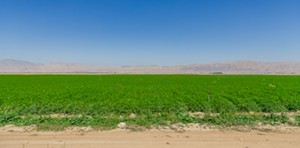
The Cuyama Valley Groundwater Basin is one of the state’s 21 critically overdrafted basins. California passed the Sustainable Groundwater Management Act (SGMA) in 2014, which required Cuyama and its fellow overdrafted basin areas to form a groundwater sustainability agency and create a plan designed to bring the basin back into balance.
After the state approved Cuyama’s groundwater sustainability plan that calls for a 60 percent reduction in groundwater use in 20 years, Bolthouse and Grimmway filed a groundwater rights lawsuit in August 2021 against all Cuyama landowners. They’re currently still serving more than 300 residents. If residents fail to get an attorney and join the lawsuit, they risk losing their water rights altogether.
“It’s now a whole other process that’s literally money sucking, and our groundwater levels have not improved at all in this whole time period,” Jaffe says.
Two tracks
Jaffe’s been involved since the beginning, she says. She sat on the stakeholders advisory committee, providing input to the 11-person groundwater sustainability agency—which included representatives from Bolthouse and Grimmway—about what pumping reductions should be made.
“With this happening literally in my backyard, there’s no way I couldn’t get involved, and I think Steve feels the same way,” Jaffe says. “The depressing reality is … this is a continual history, and we are just one more wave in the fight. It doesn’t mean we shouldn’t do it, we need to do it because if we don’t it’ll just get worse and worse.”
While the plan calls for small reductions over time (5 to 6 percent), the basin is expected to be in overdraft for the next 20 years until it reaches sustainability—where water pumped out equals water replenished, Gliessman adds. The water rights suit, aka adjudication, calls for a judge to rule on how much water everyone can pump, creating a parallel track to SGMA. However, many landowners don’t know if the groundwater sustainability plan or SGMA will impact the adjudication.
“This is all uncharted territory for California water,” he says. “Traditionally adjudications have been awarded on the basis of historical use. This is where we don’t know what’s going to happen. If it ends up being historical use, you know who’s going to get the water: The ones who caused the overdraft in the first place.”
Jaffe and Gliessman have spent between $300 to $500 a month on attorney fees over the last two years, “eating away” at their six grandchildren’s inheritance and raising concerns about their retirement, but they continue paying to stay in the fight, Gliessman said.
“When I start something I want to see it finish. I didn’t realize it was going to take so long to finish and I’m not sure it ever will be, but I’m here for the long run,” he says. “My roots are here now; we’ve planted our first plants 25 years ago and I’ve seen them grow, I’ve seen them go through a whole lot … that same thing gives me hope.”
Cuyama’s de minimis users like Gliessman and Jaffe, who use 2 acre-feet or less per year, now worry about the future of their farms as they face retirement and climate change.
Since adjudications typically take decades to resolve, many worry whether they can afford to stay in the lawsuit—but everyone is determined to keep going, said Ella Boyajian, a fellow Cuyama property owner.
“If you were a small-scale farmer and your water’s reduced, that could be your livelihood. People aren’t getting rich off of farming unless you are the corporations,” Boyajian said. “The only people making money are huge industrial farmers; everybody else is making enough to get by.”
A ‘numbing effect’

When John Caufield was 6 months old, his parents purchased an 868-acre cattle ranch in Cuyama from the Richardson family, who homesteaded the property starting in 1887.
“This ranch has been here since the 1880s, it’s had good times, tough financial times, et cetera. Now we’re facing this adjudication on my watch, and this might be one of the biggest risks that the property has faced,” Caufield said. “It used to be harder, but it’s maybe not now. It’s been a numbing effect of this is the new normal.”
Caufield, 60, grew up going to the ranch running cattle every weekend with his family and now makes the four-hour drive with his wife, Suzette, 62, from their home in Ridgecrest.
“My dad never made me sign up for the responsibility [of the ranch], but it just feels like it’s an inherited responsibility of seeing that something good happens from this,” Caufield said. “I feel some accountability for the history of the ranch and its caretaking, but there’s also the element of peace and quiet and separation from the rest of the world.”
The couple has made improvements to the property since inheriting it from Caufield’s father after he passed away from cancer in 2003. They added bathrooms and redid bedrooms while still preserving some of the home’s original features, and they continue running cattle, which are raised for beef.
“It’s really a matter of getting out, generally daily, make sure nobody’s hurt, everybody’s accounted for as much as you can because they’ll … get up in the brush and you can’t find them,” he said of the cattle.
The cattle graze on the property, rather than munching on purchased feed, and drink water from troughs. Because the troughs are mostly supplied by surface water, the Caufields only use half to three-quarters of an acre-foot per year from the basin across the entire property—making them another de minimis groundwater user, Caufield said.
Caufield said he isn’t worried about losing his groundwater rights in the adjudication; he’s more concerned about affording attorney fees. Already, the first phase of the adjudication to look at the basin’s boundaries has been pushed back three times and is now scheduled to begin in January 2024.
“Looking at it, we’ve got a lawsuit that’s filed by an entity or entities that effectively have a bottomless resource, and these things can take decades to resolve,” Caufield said. “The plaintiff has unbounded resources and time, so there’s nothing on the horizon of when this will end.”
Bolthouse and Grimmway also had representatives on the groundwater sustainability agency and provided input on the basin’s sustainability plan, which is frustrating to Caufield because the representatives were able to vote for the companies’ opinions, he added.
“To have their own attorneys challenge the plan that their representatives voted for seems odd,” he said.
Representatives from both Bolthouse and Grimmway didn’t respond to the Sun’s requests for comment.
Caufield added that he’d like to see the groundwater sustainability agency take an active stance in the lawsuit and file a brief to stand up for the plan they created.
“It seems like they should be more prepared to defend a product of their efforts as to why that plan is correct. If they are not defending their plan, if they didn’t believe in their plan, why did they send it in the first place?” he asked.
Sustainable farming
Jean Gaillard and Meg Brown can see the corporations that sued them from their front porch. Rows of bright green carrot heads dance in the sun, mocking the dusty, brown, dry Cuyama landscape in the distance.
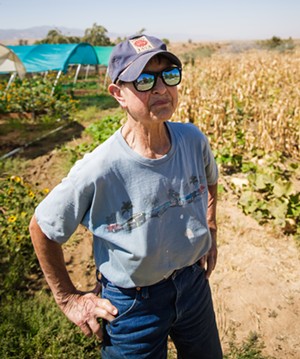
“Of course it’s always a disappointment when you see that, when you’re definitely feeling the big guys want to overrun you and say, ‘We’ve got more money, we can control the water,’ and this and that,” Gaillard said. “My opinion is the water should be more equitably distributed. It’s not only for the big moneymakers, [but for] so many people living out here.”
Gaillard, 65, grew up farming in Belgium, but it was too expensive to operate his own farm because of Belgium’s urbanization, he said. After college, he spent 20 years in Africa building irrigation systems for farmers, where he met his wife, Brown, 68, who was working for USAID at the time.
“As I worked with the farmers, I saw that they didn’t have access to the conventional systems, it was just the old way by hand,” he said. “I really realized that the crops were much nicer and healthier, and [if] I was going to go and farm, it would be more this kind of way.”
Gaillard and Brown came to the U.S. in 2005 looking for property to start a small farm. While Gaillard wanted to farm in Brown’s hometown in upstate New York, Brown was tired of the cold and opted for California, he said. The couple bought their 80-acre property and started experimenting with crops and sustainable farming techniques before becoming a registered farm in 2018, he said.
“Sustainability in farming means you have certain resources, but you don’t want to exhaust those resources because you still want to be farming in 20 years,” Gaillard said.
By using dry farming techniques, Gaillard and Brown use 1.4 acre-feet of groundwater per year to irrigate their farm. By rotating crops on the same plot of land year round, Gaillard gets more out of a smaller piece of land, and it keeps his land healthier. If any crop goes bad before they can use it, Gaillard will feed it to his goats or sheep to create manure, which will be used to improve the soil quality.
“You’re working with nature, you let nature do what it does and you’re trying to use the best point of that to grow something more resilient so that it can survive,” Gaillard said.
The couple grows zucchini, squash, sweet corn, cucumber, cantaloupe, honey dew, peaches, apples, apricots, cabbage, lettuce, plums, and persimmons for farm-to-table operations or for pickling and jams they make for deliveries. Gaillard does most of the farming and works as a horse dentist and horseshoer on the side for extra income; Brown works as the accountant, monitors orders, and runs the deliveries.
To give back to his community, Gaillard sat on the standing advisory committee for the groundwater sustainability plan, but he said he was frustrated to see the corporations turn around and sue Cuyama landowners.
He and Brown now pay about $150 a month to lawyers to stay in the lawsuit—adding up to about $1,200 a year—money he could be saving for retirement or investing in his own property to make it more sustainable, he said.
“I keep my mind on farming. That’s what keeps my head healthy because [if] you think about those problems, you might become nuts or something,” he said. “I have my horse, I’m doing things that I like, and I’m a part of the [standing advisory committee] so I feel like I’m doing something. I’m doing the best I can.”
With the looming costs and sustainability projects he still wants to complete, Gaillard said he wants to do this for another 20 years. At 65, he’s not sure if he’ll be able to keep going.
“The fact is I’m not totally finished with what I want to do in terms of farming,” he said. “When you’re starting farming, you don’t give up. You can’t give up.
“I’m not giving up, I’m a fighter.”
Fighting back
Bolthouse and Grimmway served Boyajian and her husband, Tanner, shortly after they purchased their ranch in 2021.
“When we bought this property, there was lots of hope. We wanted to spend Thanksgiving and Christmas with our extended families. We wanted cousins running around. We want our girls, they love it now and we want them to love it forever and have this home base,” Boyajian said. “That dream is complicated when you factor the realities of water.”
Boyajian, 35, grew up in Tacoma, Washington, and moved to Los Angeles to attend Loyola Marymount University, where she met Tanner. As time went on, the couple moved farther and farther away from big cities and wanted to buy a rural property where their two girls (3 1/2 years old, and 1 1/2 years old) could grow up.
“The lawsuit has complicated matters because I think there’s a fear [of] will we have enough water rights after the adjudication to do the dreams we have on the property?” Boyajian said.
Seeing fellow small farms cutting back on water use, Boyajian said she’s interested in opening up her property for tourism, possibly creating a Hipcamp or hiking trails, to highlight the nature and lifestyle in Cuyama. Moving to Cuyama, she had to play catch-up to learn about the water issues, like wrapping her arms around the beast of an adjudication.
While she was sitting with her neighbors discussing the lawsuit, one had an idea: “We should boycott carrots,” she recalled.
“We debated it amongst ourselves, the pros and cons, these farms grow more than carrots, but this could hurt carrots that aren’t Grimmway and Bolthouse,” Boyajian said. “Ultimately, we decided it was a bold message because they are 80 percent of the carrot market. They have lots of subsidiaries below them, chances are you’re buying from one of them.”
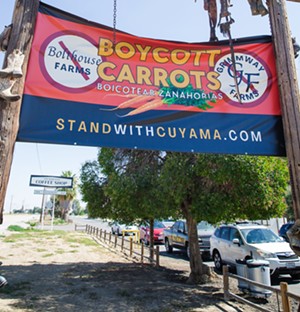
On July 30, Boyajian and her neighbors launched the boycott at the Buckhorn, where more than 150 people showed up and agreed to stop buying Bolthouse and Grimmway products, specifically carrots, and signed a petition to ask the corporations to drop the lawsuit.
Signs calling people to boycott Bolthouse and Grimmway now line Highway 166 and people’s properties. Known as Stand With Cuyama, the boycott’s Change.org petition had gained 7,560 signatures as of Oct. 10.
“We are thrilled with that because the valley is less than 2,000 people, and we’d like that momentum to continue and have more people learn about our struggle and the cause,” Boyajian said. “If we could impact their sales in one specific area like carrots, if we could make an impact on that area, that could be leveraged to negotiate or talk to us because they might see that trend of sales decreasing.”
The Stand With Cuyama team is attending a local fundraiser in November and hoping to raise more money to support the boycott’s efforts, she said. Eventually, Boyajian said she’d like to host a larger in-person meeting to help delegate more tasks for the boycott and encourage people to shop locally and seasonally.
“We have gotten farther and farther away from eating what is seasonal and being patient with what we want. It’s driving that corporate greed. They are looking out for themselves and their self-interests,” she said. “These aren’t companies committed to Cuyama and [staying] here long term. No way. They’ve got five to 10 years.
“They are figuring out how much they can squeeze out before the water’s gone.”
Reach Staff Writer Taylor O’Connor at [email protected].


